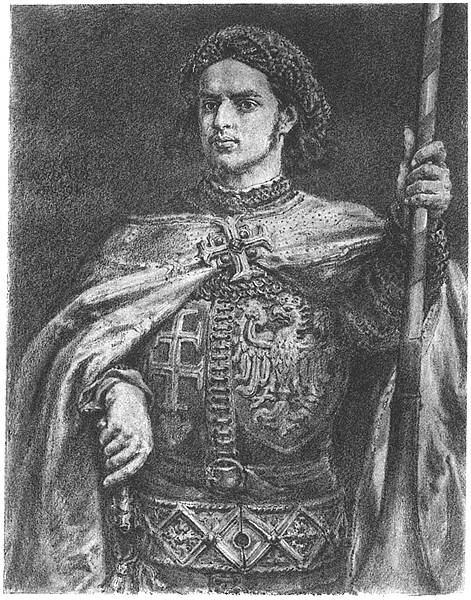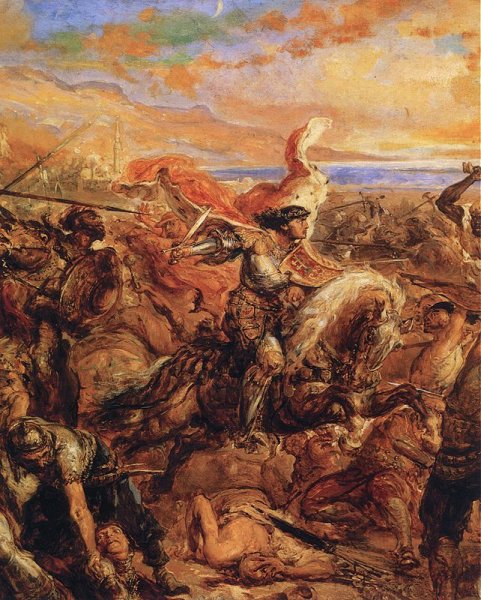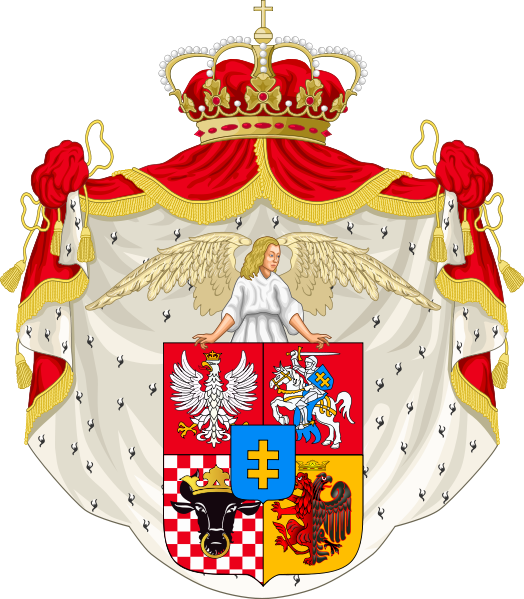<Back to Index>
- Mathematician Abraham Wald, 1902
- Writer Krišjānis Barons, 1835
- King of Poland Władysław III Warnenczyk, 1424
PAGE SPONSOR



Władysław III of Varna (31 October 1424 – 10 November 1444, Varna, Bulgaria) was King of Poland from 1434, and King of Hungary from 1440, until his death at the Battle of Varna.
Władysław III of Varna is known in Hungarian as I. Ulászló; in Polish as Władysław Warneńczyk; in Slovak as Vladislav I; in Czech as Vladislav Varnenčík; in Bulgarian as Vladislav Varnenchik (Владислав Варненчик); in Lithuanian as Vladislovas III; in Croatian asVladislav I. Jagelović. Władysław was the first born son of king Władysław II Jagiełło (former Grand Duke of Lithuania Jogaila) and queen Sophia of Halshany. He ascended the throne at the age of ten and was immediately surrounded by a group of advisors headed by Cardinal Oleśnicki,
who wanted to continue to enjoy his high status at court. In spite of that, the young ruler and his ambitious mother
were aware that there was opposition to them. Despite the agreements
signed between Władysław Jagiełło and the Polish magnates to ensure the succession for his sons, the opposition wanted another candidate for the Polish throne - Frederick of Brandenburg, who was betrothed to Hedwig,
Jagiełło's daughter by his second wife. However, the conspiracy was
resolved by the death of the princess, rumoured to have been poisoned
by Queen Sophia. The young king's reign was difficult from the very outset. His coronation was interrupted by a hostile nobleman, Spytko of Melsztyn.
On the next day, the customary homage of the townsfolk of Kraków
did not take place due to a dispute between the temporal and spiritual
lords of Mazovia over
their place in the retinue. Neither did Wladyslaw have much to say
later about matters of state, which were run by the powerful cleric and chancellor Zbigniew Oleśnicki. The situation did not change even after "seym" (parliament) had gathered in Piotrków in 1438, and declared the fourteen year old king to have attained his majority. This situation continued until 1440, when Władysław was offered the crown of Hungary. However, accepting it would have led to numerous problems. Hungary was under a growing threat from the Ottoman Empire, and some Polish magnates did not want to agree to the king of Poland also being the monarch of Hungary, while Elisabeth, widow of the deceased King of Hungary, Albert II of Germany,
attempted to keep the crown for her yet unborn child. Such
inconveniences aside, Władysław finally took the Hungarian throne,
having engaged in a two year civil war against Elisabeth. He had
received significant support from Pope Eugene IV, in exchange for his help in organising an anti - Turkish crusade.
The eighteen year old king, although thus far a king solely by title,
became deeply involved in the war against the Turks, having been
brought up in standard of a pious Christian monarch and ideal Christian knight, paid no heed to the interests of Poland and of the Jagiellonian dynasty. The "bulwark of Christianity" and other slogans put forward by the papal envoy Giuliano Cesarini, together with much more reasonable but only verbal promises of Venetian and papal fleets blockading the Dardanelles Straits, along with an enticing vision of a promise of victory in this glorious crusade carried for the glory of God and against the infidel Turks, persuaded Władysław to engage his freshly victorious forces (long campaign) for another season of war, thus breaching the ten year truce with the aggressive and still powerful Ottoman Empire.
The young king was perturbed by the breach of the treaty and perhaps
might have accepted the argument by the papal clerics that this
ten year truce signed in 1443 in Oradea was
not valid since the infidel Turks could not be trusted to keep their
word. Despite their alleged forthcoming help the Venetian fleet carried
over the Turkish army from Asia into Europe and failed to sail to Varna,
a surprising move that Władysław and his most senior military commander
Hunyadi failed to anticipate. The treason by the Venetians placed the
huge Turkish army (60,000) under sultan Murad II in close proximity to the unsuspecting crusaders (20,000). Therefore, when the Battle of Varna began
on 10 November 1444, the Polish king and his multi-ethnic subjects did
not sense that this would be for many of them their final fight.
The outnumbered royal army was further betrayed by the allied Wallachian
contingent that fled the battlefield after plundering the Turkish
baggage train. Facing the desperate circumstance the king, with
experienced Hunyadi fighting and breaking the Sipahi cavalry, decided
to gamble and attack the very persona of the sultan, protected by the
guard cavalry and the formidable Janissary infantry. The young king was
killed, leading personally his own royal Polish heavy cavalry, 500 strong, company (banner), his charge losing impetus and coming to a standstill amongst the unyielding Janissaries, amongst whom sultan Murad II was seeking safety. Neither the king's body nor his armor were ever found. Władysław III had no children and did not get married. (Jan Długosz,
known for his rather rabid antipathy towards the young king and his
father, alleged that he might have had some deviant proclivities/tendencies, but did not specified what kind proclivities
those might have been other than having to do with "lust" - Polish. Lang "zbyt chuciom cielesnym podległy (…) nie porzucał wcale swych sprośnych i obrzydłych nałogów (…)" ). He was succeeded in the Kingdom of Poland by his younger brother, Duke of Lithuania, Casimir IV Jagiellon in 1447, after a three year interregnum. In Hungary he was succeeded by his former rival, the child king Ladislaus Posthumus. According
to Portuguese legend Władysław survived the Battle of Varna (although
the Turks claimed to have his head, his body in royal armor was never
found) and after his journey to the Holy Land. He became knight of Saint Catharine of Mount Sinai (O Cavaleiro de Santa Catarina) and then he settled on Madeira Island. King Afonso V of Portugal granted him the lands in Cabo Girão district of the Madeira Islands, rent free for the rest of his life. He
was known there as Henrique Alemão (Henry the German) and
married Senhorinha Anes (the King of Portugal was his best man), who gave him two sons. He established a church of Saint Catherine and Saint Mary Magdalene in Madalena do Mar (1471). There he was portraited as Saint Joachim (São Joaquim) meeting Saint Anne at the Golden Gate on a painting by Master of the Adoration of Machico (Mestre da Adoração de Machico) in the beginning of the 16th century. According
to legend, he felt his defeat in battle as a warning from God (since he
declared war on a false pretext, violating the truce with the Ottoman
Turks), and he wandered as a pilgrim, seeking forgiveness, he found in
Jerusalem. For the rest of his life he would live in total denial of
any Polish title; there are historical records that Polish monks went
to Madeira to question him and certified he was in fact long lost King
Wladislaw III, living in secrecy, and that he refused to return to
Poland and assume the throne. Portuguese author Manuel Rosa suggests that one of King Wladislaw III's sons was Christopher Columbus.
As a sign of respect, there is a boulevard in Varna, called Vladislav Varnenchik, a residential district in Varna with the same name, as well as a successful football team named Vladislav Varna in past times. There is also a park with symbolic Cenotaph of Wladislaus III in Varna.